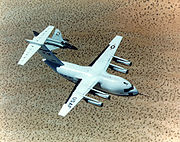
Advanced Medium STOL Transport
Encyclopedia

United States Air Force
The United States Air Force is the aerial warfare service branch of the United States Armed Forces and one of the American uniformed services. Initially part of the United States Army, the USAF was formed as a separate branch of the military on September 18, 1947 under the National Security Act of...
service with a new aircraft with improved STOL
STOL
STOL is an acronym for short take-off and landing, a term used to describe aircraft with very short runway requirements.-Definitions:There is no one accepted definition of STOL and many different definitions have been used by different authorities and nations at various times and for a myriad of...
performance. Increased need for strategic airlift led the Air Force to cancel the AMST program and seek a larger airlifter.
History
The Advanced Medium STOL Transport project arose from a USAF requirement released in 1968. The official RFP was issued in 1972, asking for a C-130-class aircraft with short take-off and landing capability. This included operating from a 2000 feet (609.6 m) semi-prepared field with a 400 nautical miles (740.8 km) radius with a 27000 pounds (12,247 kg) payload. The C-130 of that era required about 4000 feet (1,219.2 m) for this load.Five companies submitted designs at this stage of the competition. On 10 November 1972 the downselect was carried out, and Boeing
Boeing
The Boeing Company is an American multinational aerospace and defense corporation, founded in 1916 by William E. Boeing in Seattle, Washington. Boeing has expanded over the years, merging with McDonnell Douglas in 1997. Boeing Corporate headquarters has been in Chicago, Illinois since 2001...
and McDonnell Douglas
McDonnell Douglas
McDonnell Douglas was a major American aerospace manufacturer and defense contractor, producing a number of famous commercial and military aircraft. It formed from a merger of McDonnell Aircraft and Douglas Aircraft in 1967. McDonnell Douglas was based at Lambert-St. Louis International Airport...
won development contracts for two prototypes each. This resulted in the YC-14
Boeing YC-14
The Boeing YC-14 was a twin-engine short take-off and landing tactical transport. It was Boeing's entrant into the United States Air Force's Advanced Medium STOL Transport competition, which aimed to replace the Lockheed C-130 Hercules as the USAF's standard STOL tactical transport...
and YC-15
McDonnell Douglas YC-15
|-See also:-References:NotesBibliography* Green, William. The Observer's Book of Aircraft. London. Frederick Warne & Co. Ltd., 1976. ISBN 0-7232-1553-7....
, respectively.
Both the YC-14 and YC-15 met the specifications of the contest under most conditions. Both types had higher drag than expected, which decreased performance.
The increasing importance of strategic vs. tactical missions eventually led to an end of the AMST program in December 1979. Then, in November 1979, the C-X Task Force formed to develop the required strategic aircraft with tactical capability. The C-X program selected a proposal for an enlarged and upgraded YC-15 that was later developed into C-17 Globemaster III
C-17 Globemaster III
The Boeing C-17 Globemaster III is a large military transport aircraft. Developed for the United States Air Force from the 1980s to the early 1990s by McDonnell Douglas, the C-17 is used for rapid strategic airlift of troops and cargo to main operating bases or forward operating bases throughout...
.

